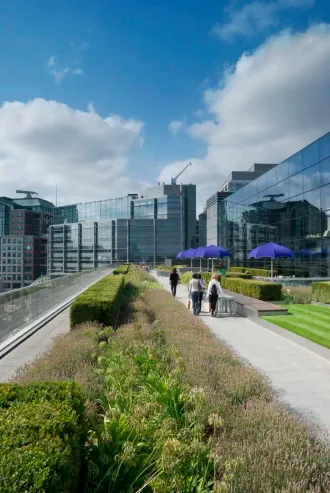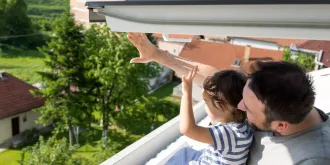Our country pages
Africa
Europe
Search
The clubhouse roof at Kytäjä Golf now neutralises air pollution

Quality is also responsibility
Kytäjä is a familiar place for golf enthusiasts in Southern Finland. Located a couple of hours' drive from the capital, Kytäjä Golf attracts thousands of players every year to enjoy the stunning surroundings and quality facilities.
Kytäjä Golf, one of the top golf courses in Finland, aims to be among the best in Northern Europe. Kytäjä Golf is already ranked 73rd in the TOP 100 modern courses in Europe, which is the best ranking of any golf course in Finland.
According to Koivu, one of the indicators that affect the overall picture in Kytäjoki - in addition to the quality criteria related to the field itself - are more responsible choices. That's why energy is now generated by the clubhouse's own roof-mounted solar panels, while the light-coloured roof beneath the panels cleans the air.
Jump to section
A more eco-efficient roof than a solar roof
When the renovation of the clubhouse roof became an issue, Kytäjä Golf started to look for ways to put the roof to good use.
At the suggestion of Icopal Katto Oy, the roof contractor, it was decided to make the roof even more eco-efficient: the new roof could also clean the air.
The Noxite coating developed by BMI Icopal is a high-quality waterproofing material that also neutralises harmful emissions from the air through a simple mechanism.
PolarTop Noxite air purifying roof for the clubhouse
PolarTop Noxite, developed by BMI Icopal, is a durable, strong and long-lasting cover. At the same time, it is more than a roof: Noxite's topcoat contains titanium dioxide, which has the special property of being able to neutralise harmful nitrogen oxides in the air into a small amount of nitrate.
The cleaning properties of titanium dioxide have been known for a long time. BMI Icopal integrated the material into the roofing material in its product development, making eco-efficient use of large roof surfaces: Noxite roofs clean the air together with the sun by their very existence.
This is how the air purifying Noxite cover works:
This is how the air purifying Noxite cover works:
- UV radiation from the sun activates the titanium dioxide on the surface of the Noxite coating, which acts as a catalyst to convert the nitrogen oxides into a small amount of nitrate.
- The nitrate is washed off the roof with rainwater. The nitrate content of the flushing water is lower than that of the mineral water.

Roofing partnership ensures a long life cycle
Every roof needs maintenance - even a brand new or newly renovated one. All roofs should be visited twice a year to carry out the necessary maintenance and to make sure everything is in good working order. With a roofing professional as your partner, you can be sure that your roof will be properly maintained, and any faults will be dealt with as soon as they occur.
In its partnerships, Kytäjä Golf also invests in quality and expertise in roof maintenance: After the roof renovation by Icopal Katto Oy's contracting service, the roof of the Kytäjä Golf clubhouse will be maintained by Icopal Katto Oy's Maintenance Services. The roof will now receive regular maintenance twice a year. This will ensure that the roof remains in good condition throughout its designed lifetime.
Get to know the services of Icopal Katto Oy
Get to know the services of Icopal Katto Oy
- Number one in bituminous paving in Finland
- Part of BMI Finland which is part of the international BMI Group
- Roof tiling and other waterproofing for new and renovated buildings
- Icopal Katto Oy's Maintenance Service for regular roof maintenance, inspections, surveys, snow removal and leak repairs

Project Highlights
Project Highlights
- Client: Kytäjä Golf
- Location: Kytäjä, Hyvinkää (Southern Finland)
- Roof contractor: Icopal Katto Oy
- Products: PolarTop Noxite cover

FAQ about Green Roofing
What is a green roof?
A green roof is a flat or sloping roof covered with vegetation. When building a green roof, it’s important to think about its composition, which must be made up of layers of different but interacting materials to ensure
- water accumulation
- water tightness
- protection against root action
- mechanical protection
- draining and filtering activity
- nutrients get to the plants.
Are green roofs eco-friendly?
Green roofing has a lot of benefits when it comes to dealing with sustainability, the environment and climate change concerns, particularly smog and pollution. These benefits include
- encouraging wildlife: rooftop habitats can provide a 'green link' that connects natural pockets of habitat to each other. They can also provide isolated habitats that are not disturbed by other green areas at ground level
- improving air quality: green roof plants improve air quality by absorbing atmospheric carbon dioxide and releasing oxygen.
- improving temperature regulation: through the daily cycles of condensation and evaporation, plants are able to cool and humidify the surrounding air, improving the microclimate
- reducing and slowing stormwater runoff: in urban areas in certain climates, green roofs can retain nearly all storm-related water during the summer months, and up to 20% during the winter months.
What are the best plants to use on a green roof?
It is often best to plant species on a green roof that require minimal maintenance. Vegetation composed of sedum essences can survive extreme drought and easily regenerate and self-propagate.
Green roof design can also include Blue Green Roof technology, which offers all the performance features typical of green roofs while offering the possibility of storing, conserving and reusing rainwater. It is also a useful solution for reducing the effects of extreme rainfall that can cause localised damage.
What is the most eco-friendly roofing material?
When it comes to choosing roofing materials, strong, durable and - more recently - eco-friendly characteristics are most often selected. These traits are available in both materials and solutions. For example:
- wooden shingles: these are shingles made from shredded wood from controlled forests
- slate and clay roof tiles: terracotta roof tiles are made from porous ceramic with clay as its base. Clay is a natural material and has been used in the building process for centuries due to its durability and low maintenance
- solutions with unique characteristics: such as Noxite bituminous waterproofing membranes, which not only provide a high-quality flat roof, but reduce pollution by using the sun to transform harmful nitrogen oxides (NOx) into harmless nitrates, which are washed away by the rain. Noxite is a highly effective means of reducing the ongoing environmental impact of a building as it continues to function throughout the life of the roofing membrane
- green roofs: the green roof solution reduces the heat island effect, boosts the insulation capacity of the environment below and improves air quality
- cool and white roofs: these reduce roof radiation by reducing overheating and so the air conditioning required.
Are green roofs expensive?
The price of a green roof depends on the size of the roof, the steepness or pitch, the type of green solution chosen and the vegetation planted. When considering the cost, remember to take into account the benefits of green roofs as a source of clean air, emotional wellbeing and environmental diversity.
If you’re investing in a green roof, it’s important to know exactly what the benefits are so that you get a great return on investment:
- roof membrane protection: vegetation on a roof deck protects the roof surface from the extremes of weather, temperature and UV radiation, which can significantly increase its lifespan
- reduced storm water run-off: water is stored by the green roof substrate and then taken up by the plants, where it is returned through transpiration and evaporation into the atmosphere. The drainage layer in green roofs also delays the rate at which water run-off occurs, reducing stress on drains and sewers during heavy rainfall
- reduced energy costs: the layers of a green roof system improve the thermal performance of the roof, helping to keep the rooms below cool in summer and warm in winter (although this effect is generally not included in any U-Value calculations).
How long do green roofs last?
Green roofs can extend the life cycle of a roof for more than 30 years as its layering makes it more durable than normal roofs. It is important, though, that the membrane and the stratigraphy (or layers) are correctly installed.
How long does a flat roof last?
A flat roof usually has an average lifespan of about 15 years. Many of its components require maintenance from time to time and, if this is not done, the roof can be damaged by infiltration. To make the roof last as long as possible, it is important to carry out frequent inspections and work on the drainage system.
How frequently should roof maintenance be performed? And what does this involve?
The health of the roof changes over time depending on the attention you give it. To ensure high quality roof products remain fully functional over decades, it is essential to follow a regular maintenance programme.
Maintenance problems normally include infiltration, cracks in the roof covering or tiles, deterioration of the membranes and insulation. If not repaired, the roof's insulating performance will decline.
Inspect your roof after storms and high winds, and at major discontinuity points, and clean it periodically.
And remember to check your product’s warranty, whether you have installed just a few tiles or an entire roof system. A good warranty can protect you from costly repairs in the future.
How do you install a green roof?
A green roof is a surface that needs to be made waterproof to avoid damage from water seeping in. So, it is essential to have an anti-root membrane and a draining layer that will help carry away excess water from the rain or gutters.
Then, adding a drainage mat and felt layer will allow the water to pass through and the roots to attach themselves to the growing medium. The drainage layer will then provide the growing platform for the green roof. The composition of the soil is also important as it aids proper plant nutrition and growth.
Finally, the roof must include an irrigation system, possibly water-based, so as not to overload the roof, and reduce water consumption and waste.
If you choose an intensive green roof, you can plant classic garden plants, both herbaceous and shrubs. If you opt for an extensive green roof, low-lying and creeping plants are best as they are suitable for growing in thin layers of substrate.
What is a blue roof and why is it considered environmentally friendly?
A blue roof can be key to sustainability in buildings, particularly in urban areas where a ground level solution may not be possible due to lack of space. Benefits of a blue roof include
- temporarily store rainfall to reduce runoff
- reduce the flow rate of water from the roof
- store water for reuse in other areas of the building, such as irrigation or cooling
- make up the drainage and support layers for green roofs
- Easy to maintain.
If your business is located in an area particularly prone to flooding, then a blue roof system can also help to protect your building (and neighbouring ones) from damage.
Contact Us
Contact our local team
We can support you to define solutions and services for specific country.
Media Contact
Contact us for more information on BMI Group
group.communications@bmigroup.com




